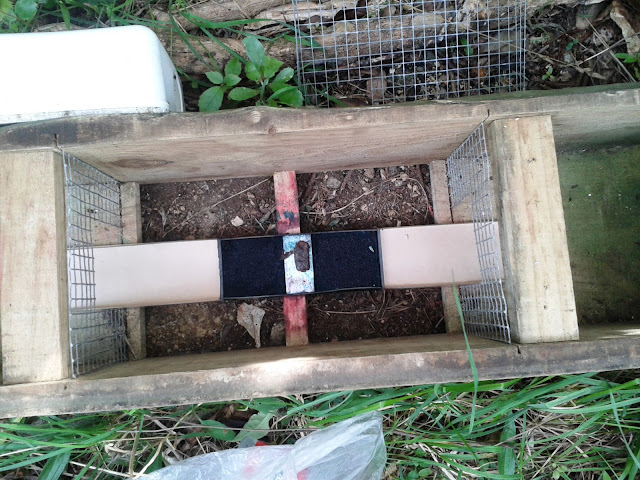 |
| A female putangitangi testing the waters |
Today I took on a new activity at Zealandia. As ship tours, kaka nest box monitoring and transect cutting jobs decline, other work needing to be done springs up in their place.
I was to work alongside another volunteer to learn the ropes and while I waited I strolled over to the bottom dam to see if any ducks were hanging out in the area. I was not disappointed and saw an extended papango or scaup family watching over one chick. The females seemed to be having a gossip while two males shepherded the chick. A couple of pateke were lurking near the grassy overhang and a shelduck pair were ambling along the dam getting ready for a morning swim.
 |
| A family of papango |
Seeing my partner turn up I walked back to the task at hand.
 |
| What we have to look for |
Preparation and monitoring of tracking tunnels is done twice a year and is under way at present. I was to tag along and learn the ropes before heading out on my own later in the week or when the weather dictates.
The route we were allotted was on tracks I knew well - a climb up to the eastern perimeter then down the pylon track, around the lake track and back along the Beech Track to the main track and home.
 |
| A tracking tunnel - later on a poison or trap will be inserted if necessary. |
Every two hundred metres or so we would find an oblong wooden box. Our job was to take the lid off and check the run track inside. The track consisted of a piece of bait in the middle, and two ink pads plus two absorbent blotter papers on each side.
First we checked to see if the bait had been taken or not. This bait is not poisonous. It is an attractive food such as peanut butter, rabbit jerky or fresh meat to encourage pests to enter and leave their footprints behind. It allows us to know what is roaming about in the Sanctuary. Hopefully we will find nothing nasty but we cannot afford to be complacent. If a footprint of a mammalian predator such a rat is found something lethal will be put out to get them. The majority of New Zealand birds cannot thrive alongside mammals as they have evolved without their presence until the arrival of man and his four legged imports. All it will take is a few rodents to find their way into Zealandia to threaten many species unless they are dealt to pretty swiftly.
And that is where staff and volunteers come in. It takes constant vigilance to prevent breaches of the fence plus checks in case something makes it through.
 |
| Bait gone, lots of little foot prints, conclusion: mice have been visiting. |
The papers showed that indeed a mammalian pest was frequenting our tracking tunnels but it was not a surprise. The bait was gone and there were lots of little footprints. Mice! This is the one pest that has proved impossible to keep out. A small distortion of the fence will open up a gap big enough for a baby mouse to squeeze through. Ruru, and falcon could drop a live mouse inside.
 |
| A tracking box with fresh bait, fresh blotter paper and nice wet ink pads to collect footprints |
We then removed the papers and replaced them with fresh ones. New bait was added. The food of choice this time round was rabbit jerky which is quite easy to handle. New ink was applied to the ink pads. This was the trickiest bit as the ink does its job well and attaches itself to fingers with the slightest encouragement.
No one seems to manage a round without inky fingers. We dated the used blotter papers and placed them in a notebook so that they could be checked again in case we missed a significant footprint.
We continued around the route finding evidence of mice in some areas but not in others. There were little scratchy prints caused by invertebrates such as weta. In one box there was a funny sort of smear. 'Tuatara,' said my companion. So if you come across a tuatara with a blue or pink tummy when visiting Zealandia, you'll know why!
Almost finished we passed by the tuatara fence. There clinging to it was a lovely large Wellington forest gecko. This was the second time I have seen one in the Sanctuary and it is such a thrill as I have never seen one outside Zealandia in the wild.. Our efforts at keeping predators at bay not only help the birds but also our skinks, geckos and invertebrates. He - well, I think it was a he - was a large beautiful specimen with chevron patterning in a variety of greys. We stopped to take a photos of him then continued on our way to put back our gear in the Ops Shed and for me to escape for lunch.

No comments:
Post a Comment